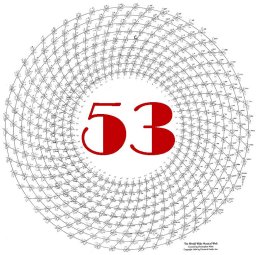Harmonic Intervals East vs. West
Let’s compare the harmonic intervals employed by India to those in our Western world. In India, thirds and thirds of thirds were commonly accepted harmonies for at least a millennium. In Europe, even the just major third (5/4) was considered a “dissonance” until the Ars Nova Period (starting around 1300). After centuries of 3-limit musical purity in the Catholic Church, 5/4 (the fifth harmonic) was accepted as a consonance at the same time that music took a strong turn towards personal emotional expression. The just minor third (6/5, attained by going up a fifth and down a just third on the lattice) is a powerful emotional “inversion” of the major third. If the major third is employed in a song of love, the minor third is used in a song of loss. In 12-eq, however, we don’t capture the true affect of major and minor thirds. The 12-eq major third is 14 cents sharp from the natural third, which is one reason why our music sounds so restless. By contrast, the natural, just major third has an affect of contentment. The 12-eq minor third is 14 cents lower than the just minor third. The piano’s 12-eq minor third is actually an out-of-tune version of the Pythagorean 81/64 (8 cents off) and not the ga-relation of 5/4 (14 cents off) at all. All four of these thirds evoke very different feelings in me.
To my ear, the just major third triggers an emotion of fulfillment and mellow joy. The Pythagorean 3-limit major third is 22 cents higher with a ratio of 81:64, and it seems brighter. The 12-eq major third is 14 cents higher than the 5/4 Just Third and 8 cents lower than the Pythagorean Third. It’s out of tune with both and seems a little manic and unresolved by comparison. The just minor third (C-E1b) evokes in me a feeling of passion and yearning. The power of that feeling is diminished with the Pythagorean minor third, which is a narrower interval by 22 cents and to my ear creates more of a feeling of stoic resignation. Then there is the still-lower septimal minor third (the 7/6 ratio, C-E1b), which blues singers employ to express the feeling of the bottom falling out completely. We’ll talk more about the septimal minor third in a future chapter. Finally, I play the 12-eq minor third, whose 14-cent out-of-tune flatness makes me feel more sad, despairing, desperate. Listen to the sounds of Figure 9-4 (Just major vs Pythagorean major vs 12-eq major; just minor vs Pythagorean minor vs septimal/blues minor vs 12-eq minor). What kinds of emotions do these different thirds evoke in you?
Figure 9-4: thirds Just vs Pythagorean vs 12-eq major thirds
Figure 9-4 continued: Just vs. Pythagoran vs. Septimal vs. 12-eq minor thirds
In India, the just major third interval is expressed with the syllable GA….
If you would like to learn more about this chapter, “Harmonic Intervals East vs. West,” you can buy the entire book, The Grand Unified Theory of Music, in pdf form and on a complete website for $25 with hundreds of embedded musical examples of scales and chords from all over the world.
A free introduction to what The Grand Unified Theory of Music offers is on this website and includes both text and a few musical examples from each webpage. If you would like to learn more about this chapter and the full contents of this entire e-book, you can buy The Grand Unified Theory of Music for $25, with hundreds of embedded musical examples of scales and chords from all over the world — and ideas for how to set up your computer system —
HERE.
You’ll get a personalized password you can use to see the entire e-book. Inside the full book, you will also get a link to the complete pdf file of this e-book, which you can read on your Kindle or similar device. The links to the hundreds of mp3 sound files – the same ones you can hear on the website — will also be included. This is “Version 1.0” of The Grand Unified Theory of Music. Because it is an e-book, additions, corrections and improvements in the sound may be added at any time. The Grand Unified Theory of Music is Copyright © 2018 by Christopher Mohr. All rights reserved.
One person per password. Sharing this password with others is a violation of copyright. Do not allow others to use your password or link to the pdf file!
